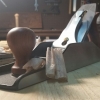Different alphabets. Different sizes.
The 'straights' use chisels; so that's easy. But all those different curves? What gouges do you need to cut them? Which are the best, the most efficient?
Here's the answer. Or, rather, here's how to work out the answer! It's all about geometry; understanding how the gouge with its 'sweep' (or arc) works relative to the wood and what you can do to change it. Understanding this makes it straightforward to pick the right gouge for any curve.
Grasping this fundamental geometry is gold and will impact all your carving. Really. So get out your gouge and absorb ...

| 03 October 2016 16:19
Siegmar - I'm sorry to disappoint but, although that might be possible one day, we have a schedule of other videos to get through in the immediate future.
However, if you understand how to carve curves and the other elements that make up an alphabet, you should be able to carve this particular type of letter. Start by practising carving just one letter. The O and the I are good ones to begin with. Then, when you have got those under your belt, move onto more complicated letters, say the D and E; then perhaps the B and A - and so on. Just take it one step at a time. Because the elements are repeated through an alphabet, you will soo sped up and before you know it you can tackle he whole thing.

| 02 October 2016 01:46
The book BUCHSTABEN" ( "Letters") von Kurt Koch; von Eulenkopf-Verlag, Deutschland, shows the Alphabet FRAKTUR. Could you mäke a video of this letters?

| 28 April 2016 16:52
William - I'll give some thought to your idea but, to be honest, I'm not sure I could successfully teach the drafting of letter patterns. I sort of just do it. The best thing for you to do is study the letter forms etc without reference to carving. Think of it like this: Carving the letters into wood is just a way of fixing the drawing! The best lettercarvers (in stone or wood) all come from a strong calligraphy or letter drawing background.

| 24 April 2016 19:44
Your drafting of letter patterns is something to envy. Might you do a video show explicitly how you draft your patterns? Shaping the letters is more complicated to understand than spacing the letters. Any resources you have found to help for the former would be welcome.

| 01 March 2015 13:35
Andrew - I believe I'm using Auriou gouges here, from the Auriou lettering set - there's a link in the directory on the left. I don't know about any Pfeil letteing sets I'm afraid. Really, though, you need to be thinking backwards: Find the alphabet you want to carve and draw/print it out at the size you want. Then look at the curves and apply the 2 rules I give in the video. A good idea might be to stick the lettering on the window (or a light box) and overlay it with a print of the Sheffield lis of sweeps. In that way you can see one against the other and how they relate. Then you buy the specific tools you want, rather than working from a set of tools to some letters they might carve...

| 26 February 2015 17:22
Hi Chris,
Two things please:
1. Re Choosing gouges for curves video. I'd like to get the true gouge you used as it looks the right size for my biggish hands and the other slightly flatter one. I couldn't find them on the sites you quoted.
2. I bought the Pfeil 6 piece for small lettering and it is really small; what is the mix of the next size up?
Many thanks,
Andrew.

| 22 February 2015 14:36
Derek - The book is 'Buchstaben' ('Letters') by Kurt Koch; published by Eulenkopf-Verlag, Germany. The text is in German. I don't know of an English translation or where you might buy it from but no doubt Google can tell you! To be honest, although Koch is a well-known carver, I haven't found the book that useful - a lot of the alphabets are pen-style letters and although you CAN carve them, they don't lend themslves to a use of tools that is simple and efficient: always a good sign of a carveable alphabet. Non-the-less, there are a few good ones and, really, I think it only takes one to make a book worth buying.

| 21 February 2015 03:05
Endless application here. Personally, I experienced the most improvement in my overall skills after I started letter carving. I encourage anyone seeking improvement to commit to letters if just for a few weeks. Hugely beneficial and ultimately translateable. There is a whole series featuring a beardless Chris in the letter carving section over there ??